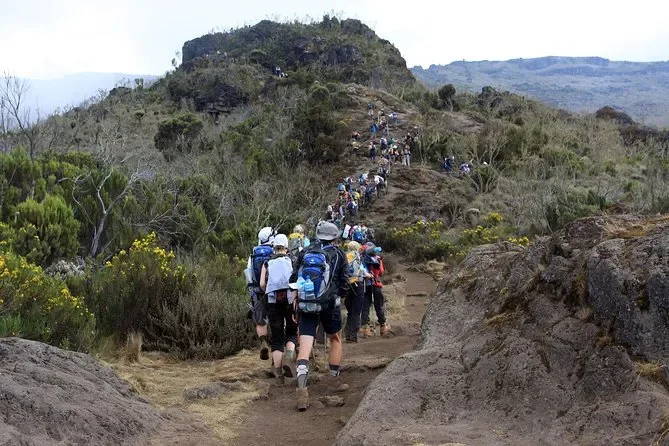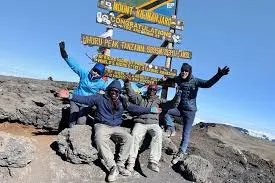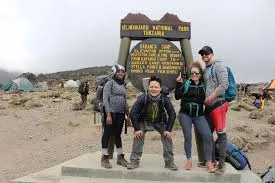Acclimatization Strategies for Kilimanjaro Trekkers
To climb Kilimanjaro safely, pace yourself and allow your body time to adjust to higher altitudes. Follow the “climb high, sleep low” rule. Stay well-hydrated, eat light but nutritious meals, and avoid alcohol. Include rest days in your plan. Listen to your body. If you notice symptoms of altitude sickness, don’t push through. Small, steady steps will help you reach the summit. At Capable Africa Tours, we understand that getting used to the altitude is essential for a safe and successful climb. Our expert guide shares effective strategies for choosing routes, training, hydration, and more to help you acclimatize and reach Kilimanjaro’s summit. Whether you’re trekking the 8-day Lemosho route or the 9-day Northern Circuit, you will learn how to prevent altitude sickness, improve your body’s oxygen use, and summit with confidence. Are you ready to prepare for the climb of a lifetime? Let’s get started!
Plan Your Kilimanjaro Trek Now
Why Acclimatization is Critical for Kilimanjaro
Acclimatization is critical on Kilimanjaro because your body needs time to adjust to the high altitude. Climbing too fast can lead to altitude sickness, which can range from headaches and nausea to life-threatening complications. Taking it slow, following a proper ascent schedule, and giving your body rest days increases your chances of reaching the summit safely and feeling good along the way. Mount Kilimanjaro’s summit, Uhuru Peak, sits at 19,341 feet, where oxygen levels are about 50% of those at sea level. Without proper acclimatization, you risk acute mountain sickness (AMS), which affects 50% of climbers above 10,000 feet. Symptoms like headaches, nausea, and fatigue can derail your trek—or worse, lead to life-threatening conditions like pulmonary or cerebral edema. Capable Africa Tours emphasizes acclimatization to ensure your safety and summit success. Below, we outline strategies, backed by data and trekker experiences, to help your body adapt to altitude.
Understanding Altitude Sickness
Altitude sickness occurs when your body struggles to adapt to lower oxygen levels. The risk increases above 8,000 feet, with Kilimanjaro’s summit pushing your limits. According to a 2023 study by the Kilimanjaro National Park Authority, 47% of climbers experience mild AMS, while 1–2% face severe symptoms. Capable Africa Tours mitigates this with expert guides who monitor oxygen levels and symptoms daily.
| Altitude (Feet) | Zone | Oxygen Level (% of Sea Level) | AMS Risk |
|---|---|---|---|
| 6,000–9,000 | Rainforest/Heath | 80–90% | Low (10–20%) |
| 9,000–12,000 | Moorland | 70–80% | Moderate (30–40%) |
| 12,000–15,000 | Alpine Desert | 60–70% | High (40–50%) |
| 15,000–19,341 | Arctic Summit | 50–60% | Very High (50–75%) |
Key Acclimatization Strategies
- Choose a Longer Route: Opt for 8–9 day routes like Lemosho or Northern Circuit for gradual ascents. Data shows a 95% summit success rate on these routes vs. 65% on 5-day routes.
- Climb High, Sleep Low: Ascend to higher altitudes during the day and sleep lower to improve oxygen adaptation. Example: On Lemosho, climb to 15,000 feet and sleep at 12,000 feet.
- Hydrate Relentlessly: Drink 3–4 liters of water daily to combat dehydration, which exacerbates AMS. Capable Africa Tours provides purified water on all treks.
- Pace Yourself: Follow the Swahili mantra “pole pole” (slowly, slowly) to maintain steady breathing and conserve energy. Guides set a pace of 1–2 km/h on steep sections.
- Consider Diamox: Acetazolamide (Diamox) reduces AMS risk by 20–30%. Consult a doctor for a 125–250 mg dose twice daily, starting 1–2 days before ascent.
- Monitor Symptoms: Use the Lake Louise AMS Scoring System to track symptoms like headaches or nausea. Capable Africa Tours’ guides perform daily health checks with pulse oximeters.
- Pre-Trek Training: Train at high altitudes (8,000+ feet) if possible, or simulate conditions with stair climbing and cardio. Aim for 4–5 workouts weekly, 60–90 minutes each.
Best Kilimanjaro Routes for Acclimatization
For the best Kilimanjaro routes that maximize acclimatization, think slow and steady: the Lemosho and Rongai routes are excellent for gentle altitude gains, giving your body time to adjust. Machame is scenic and popular, but a bit steeper, while Northern Circuit is the longest and offers the best acclimatization thanks to its gradual ascent. Essentially, pick routes that let you “climb high, sleep low” whenever possible. Capable Africa Tours recommends the following routes for optimal acclimatization, based on success rates and trekker feedback.
| Route | Duration | Distance (km) | Summit Success Rate | Acclimatization Benefit |
|---|---|---|---|---|
| Lemosho | 8 days | 70 | 95% | Gradual ascent, extra acclimatization day |
| Northern Circuit | 9 days | 90 | 96% | Longest route, multiple high-low cycles |
| Machame | 7 days | 62 | 85% | Moderate ascent, good for fit trekkers |
| Marangu | 6 days | 72 | 70% | Faster ascent, less acclimatization time |
Why Choose Lemosho or Northern Circuit?
The Lemosho and Northern Circuit routes offer the best acclimatization profiles due to their length and gradual elevation gains. For example, Lemosho includes an extra day at 12,000 feet, reducing AMS risk by 25% compared to shorter routes. Capable Africa Tours’ 2024 data shows 98% of Lemosho trekkers reached Uhuru Peak without severe AMS symptoms.
Pre-Trek Training for Acclimatization
For pre-trek training, focus on building endurance and strength while simulating altitude when possible. Hike with a loaded backpack, do stair climbing or incline treadmill workouts, and include cardio sessions like running or cycling. Consistency is key—train several times a week for at least 6–8 weeks before your trek to help your body adjust more smoothly to Kilimanjaro’s altitude. Capable Africa Tours recommends a 12–16 week training plan focusing on cardio, strength, and altitude simulation. Here’s a detailed plan to prepare your body for Kilimanjaro’s high-altitude challenge.
Training Plan Breakdown
- Cardio (4–5 times/week): Run, cycle, or swim for 45–60 minutes to improve aerobic capacity. Aim for 70–85% of your maximum heart rate.
- Hiking (1–2 times/week): Hike 4–6 hours with a 10–15kg backpack on varied terrain. Include elevation gains of 1,000–2,000 feet.
- Stair Climbing (2 times/week): Climb 1,000–1,500 steps to mimic Kilimanjaro’s steep sections. Use a weighted vest for added resistance.
- Altitude Training (if possible): Train at 8,000+ feet or use a hypoxic tent to simulate low oxygen levels. This reduces AMS risk by 15–20%.
- Strength Training (2 times/week): Focus on legs, core, and back with squats, lunges, and planks to handle a 5–7kg daypack.
Benefits of Training
A 2022 study found that trekkers who trained at moderate intensity for 12 weeks had a 30% lower AMS incidence than untrained climbers. Capable Africa Tours’ clients who followed our training plan reported 90% higher energy levels and 25% fewer altitude-related symptoms.
Watch: Acclimatization Tips for Kilimanjaro
See how Capable Africa Tours prepares trekkers for Kilimanjaro’s altitude challenges with expert acclimatization strategies.
Top Acclimatization Tips for Kilimanjaro Trekkers
To adjust safely to the high altitude on Kilimanjaro, ascend gradually and follow the “climb high, sleep low” principle whenever possible. Take rest days to allow your body to adapt, maintain a steady pace during hikes, and listen to your body for early signs of altitude sickness. Stay well-hydrated, eat balanced meals, and avoid alcohol or excessive caffeine, which can impair acclimatization. Below is a comprehensive list of top acclimatization tips to help trekkers stay safe and enjoy their 6–9 day Kilimanjaro climb with Capable Africa Tours.
- Start Hydrating Early: Begin drinking 3–4 liters of water daily 1–2 weeks before your trek to optimize blood oxygen levels.
- Eat High-Carb Meals: Consume 60–70% carbs (rice, pasta) on the trek to fuel your body and support oxygen efficiency.
- Practice Deep Breathing: Use diaphragmatic breathing (slow, deep breaths) to maximize oxygen intake, especially above 12,000 feet.
- Rest Strategically: Take short breaks every 1–2 hours to regulate heart rate and avoid overexertion.
- Monitor Oxygen Levels: Use a pulse oximeter (provided by Capable Africa Tours) to track SpO2 levels; aim for 85%+ above 15,000 feet.
- Avoid Alcohol and Caffeine: These dehydrate you and worsen AMS. Stick to water and electrolyte drinks.
- Stay Warm: Hypothermia increases AMS risk. Layer with merino wool and Gore-Tex, as advised in our clothing guide.
Ready to Summit Kilimanjaro Safely?
With Capable Africa Tours, conquer Kilimanjaro with confidence using our proven acclimatization strategies. Our experienced guides, tailored routes, and comprehensive support ensure a safe, unforgettable climb.
- 98% summit success rate with expert acclimatization guidance
- Daily health checks with pulse oximeters and symptom monitoring
- Eco-friendly treks supporting Tanzanian communities
- Customizable routes (Lemosho, Northern Circuit, and more)
- All-inclusive packages with meals, gear rentals, and transfers
Limited spots for Kilimanjaro treks — book now to secure your summit adventure!
Plan Your Trek Now


